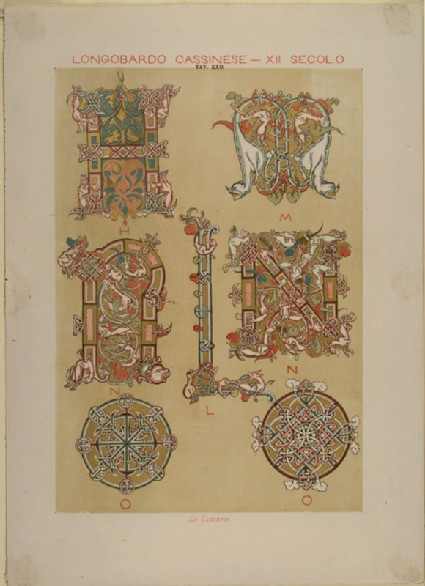Browse: 1470 objects
- Reference URL
Actions
Lithograph of illuminated Letters from a twelfth-century Manuscript at Monte Cassino Litografia di Montecassino
-
Curator’s description:
Description
The print shows seven illuminated letters, taken from a twelfth-century manuscript. Arranged in three rows of two, three and two letters respectively they are, reading from top to bottom and left to right, H, M, N, L, M, O, and O. They are decorated with interlace work, pale brown dogs, and, in the 'M', two imaginary monsters.
The print was originally plate XXII in "Longobardo cassinese", the pages and plates of which were issued out of sequence between 1877 and 1878 under the imprint Litografia di Montecassino, as dispense II-IV of "Paleografia artistica di Montecassino", edited by Oderisio Piscicelli Taeggi; this plate was in dispensa IV, issued in 1878. According to p. 17 of "Longobardo cassinese", this plate reproduces letters in codex 47 in the library of the Benedictine Abbey of Monte Cassino, dating from the late twelfth century.
According to Ruskin's lecture on "Classic Schools of Painting", delivered on 19 May 1883, he had received Piscicelli Taeggi's work just before resuming his Professorship at the beginning of the year. Consequently, the drawing does not appear in any of Ruskin's catalogues, being first listed by Cook and Wedderburn amongst the unframed objects in the Drawing School (XXI.308). As the unframed examples had not been given an order by Ruskin, they have been given arbitrary accession numbers based upon their position in Cook and Wedderburn's list for the purposes of the current catalogue. At that time, it accompanied two more plates fron Piscicelli Taeggi. Another two plates from Piscicelli Taeggi were placed in the Reference Series, as nos 198 and 199.
In his lecture, Ruskin described how 'I have chosen these four magnificent letters to place in your schools - magnificent I call them, as pieces of Gothic writing; but they are still, you will find on close examination, extremely limited in range of imaginative subject. For these, and all the other letters of the alphabet in that central Benedictine school at the period in question, were composed of nothing else but packs of white dogs, jumping, with more contortion of themselves than has been contrived even by modern stage athletes, through any quantity of hoops. But I place these chosen examples in our series of lessons, not as patterns of dog-drawing, but as distinctly progressive Gothic art, leading infallibly forward - though the good monks had no notion how far, - to the Benedictine collie, in Landseer's "Shepherd's Chief Mourner," and the Benedictine bulldog, in Mr. Briton Rivière's "Sympathy." (Art of England, § 63 = XXXIII.309-310.)
-
Details
- Artist/maker
-
Litografia di Montecassino (active 1877 - 1878) (lithographer)after Anonymous, Continental (Anonymous, Continental)
- Object type
- Material and technique
- colour lithograph on wove paper
- Dimensions
- 301 x 208 mm (stone); 482 x 309 mm (sheet)
- Inscription
- Recto:
within the image, the printed reproductions of illuminated letters are each accompanied by their equivalent printed in red in a plain sans-serif fount; reading top to bottom and left to right, the letters are H, M, N, L, N, O and O
above the image, printed in red: LONGOBARDO CASSINESE - XII SECOLO
just below, printed in black: TAV. XXII
below the image, printed in red: Lit. Cassinese.
Verso, top left, in ink: R 78
- Provenance
-
Acquired by John Ruskin in late 1882 or early 1883
- No. of items
- 1
- Accession no.
- WA.RS.UF.39.b
-
Subject terms allocated by curators:
Subjects
-
References in which this object is cited include:
References
Ruskin, John, ‘The Art of England: Lectures Given in Oxford by John Ruskin ... During His Second Tenure of the Slade Professorship’, Edward T. Cook and Alexander Wedderburn, eds, The Works of John Ruskin: Library Edition, 39 (London: George Allen, 1903-1912), 23
Ruskin, John, ‘The Ruskin Art Collection at Oxford: Catalogues, Notes and Instructions’, Edward T. Cook and Alexander Wedderburn, eds, The Works of John Ruskin: Library Edition, 39 (London: George Allen, 1903-1912), 21, cat. Unframed
Location
-
- Western Art Print Room





